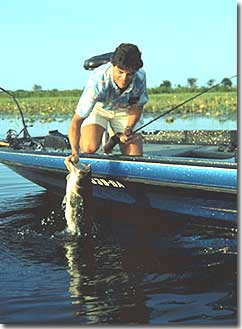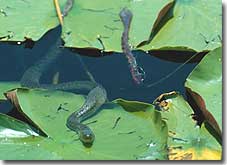Fishing Thick Vegetation for Big Summer Bass
Fishing Thick Vegetation for Big Summer Bass
By Bill Vanderford
The angler concentrated intently on the path his lure traveled over and around the thick lily pads. Suddenly and without warning, the pads and water exploded like a depth charge as the lure disappeared in a shower of spray! The bend in the baitcasting rod, however, revealed that a huge bass was on the end of the line.
 Most southern waters contain surface vegetation during the warmer months of the year. Types include hydrilla and milfoil, which are considered nuisance weeds, and both lily pads and dollar pads.
Most southern waters contain surface vegetation during the warmer months of the year. Types include hydrilla and milfoil, which are considered nuisance weeds, and both lily pads and dollar pads.
This surfacing vegetation in the shallows of a lake is generally thickest in the north and northwest part because of sun and solar exposure. In this hemisphere, the sun is always in the south, and the cold winds are normally out of the north, so the north shore is protected, yet exposed to the warm south winds and is generally two to four degrees warmer than the rest of the lake.
Weeds produce oxygen during the day, but stop producing and in some cases even consume oxygen at night. Weeds like hydrilla or milfoil are high consumers of oxygen at night, so bass will generally stay closer to the edge of these kinds of beds than they will with lily pads that offer open cover and don't consume much oxygen at night.
Despite lower oxygen levels, bass can still be caught inside the edge of the weeds. They venture in as far as their food source does.
To locate baitfish in the thick weeds, use a bright, silvery lure with plenty of flash so that it can easily be seen by the baitfish. Buzzbaits, spoons, or other highly visible lures work well. Cast one of these lures back in the thick weeds. If the baitfish scatter like welding sparks, then it’s almost certain that predator fish like bass are present.
Usually bass in the weed beds are easy to catch and hard to spook. They feel secure because of the thick cover. These areas, however, require some specialized topwater techniques. In fact, weeds offer some of the best top water fishing in the world.
If a bass is going to take a topwater lure in open water, he can suck it off the surface. When a bass takes something off the top of a weed bed, however, they have to explode much more violently and often miss their target three or four times, which makes this type of fishing much more exciting.
Bass are upward oriented, and light favors a predator close to the surface. Therefore, colors that are best and easiest to see are the ones that blend in well with the top of the lilies, and that makes sense in nature's scheme. Any critter that lives on top of the lily pads and weed beds is more concerned about exposure from the topside to birds and terrestrial predators. Bass exploit that edge.
By having colorations of greens and browns, smaller, pad-walking creatures make themselves invisible to the more immediate dangers from above, but become vulnerable to the feeding bass. This makes greens and browns good color choices for lures in the vegetation.
 Black, weedless spoons, buzzbaits, and large, snake-like plastic worms are great baits for bass in weeds. The spoons represent baitfish that have been chased out of the water and are flipping on top of the pads, while buzzbaits look more like a frog to the fish, because a frog out in the open water will often run across the surface similar to a buzzbait. The larger plastic worms just look like any number of water snakes, which are a common bass food all over the South.
Black, weedless spoons, buzzbaits, and large, snake-like plastic worms are great baits for bass in weeds. The spoons represent baitfish that have been chased out of the water and are flipping on top of the pads, while buzzbaits look more like a frog to the fish, because a frog out in the open water will often run across the surface similar to a buzzbait. The larger plastic worms just look like any number of water snakes, which are a common bass food all over the South.
When bass feed in heavy cover, they tend to take in a lot of unwanted debris as well. A bass sucks everything into its mouth including pieces of lily pads and grass. Therefore, they're not as likely to just grab the lure and spit it out like they would in open water.
The technique to use is to try and move the boat forward, cast, and cover all the water in a particular weeded area. Spread the casts out around the boat, then move the boat the distance of a cast.
This is the only type of fishing where the average bass size is as good or better than those caught on wild shiners. Though bites are less numerous, one seldom catches a bass less than five pounds using this technique, which makes fishing vegetation an explosive experience for the patient angler!
|
